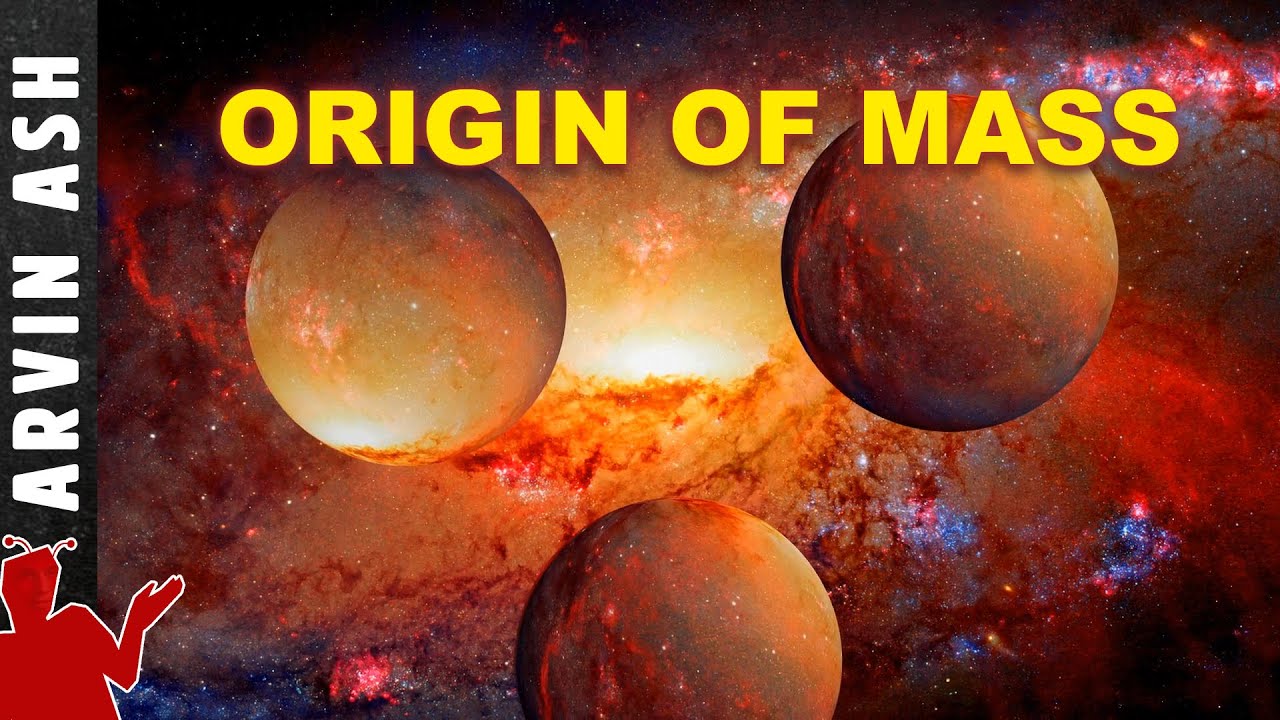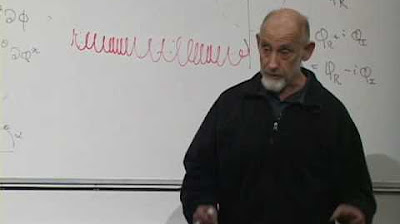The Crazy Mass-Giving Mechanism of the Higgs Field Simplified
TLDRThe video script delves into the concept of mass and weight, explaining the difference between the two and how mass originates from the energy within atoms. It introduces Einstein's mass-energy equivalence equation, E=MC^2, and discusses the role of the Higgs Field in conferring mass to fundamental particles, illustrating the idea of 'symmetry breaking'. The script also touches on the importance of the Higgs Field in the formation of atoms and the universe as we know it, emphasizing that while it accounts for only 1% of the universe's mass, it is crucial for the existence of matter as we understand it.
Takeaways
- 📈 The concept of weight is derived from Newtonian mechanics, where force equals mass times acceleration, and gravity provides the acceleration that creates force.
- 🌌 Mass is more complex than weight and is related to the energy contained within atoms, as described by Einstein's mass-energy equivalence equation E=MC^2.
- 🔬 99% of an atom's mass is found in the binding energy of the nucleus, which is maintained by the Strong Force, one of the four fundamental forces of nature.
- 🤔 The remaining 1% of mass is distributed among subatomic particles like electrons and quarks, which raises the question of how these particles acquire their intrinsic mass.
- 💫 The Higgs Field is a theoretical field that permeates all of spacetime and is responsible for giving mass to certain fundamental particles through their interaction with it.
- 📚 The Higgs Field is often explained through concepts like symmetry breaking, which is a complex topic involving advanced mathematical concepts.
- 📦 The vacuum expectation value (v.e.v.) of the Higgs field is nonzero, meaning it has a positive mass even in its lowest energy state, which is unique compared to other fields.
- 🔗 The interaction of fundamental particles with the Higgs field confers mass upon them, with the amount of mass depending on the strength of the coupling between the particle and the Higgs field.
- 🚀 Without the Higgs field, fundamental particles like electrons would be massless and would move at the speed of light, leading to a vastly different universe.
- 🌟 The Higgs field is responsible for only about 1% of the mass of all visible matter in the universe, but this small percentage is crucial for the formation of atoms and the existence of the universe as we know it.
- 🔍 Neutrinos are an exception in the Standard Model, as they are predicted to be massless, yet measurements suggest they have a very small mass, the origin of which remains unknown.
Q & A
What does the number on a scale represent?
-The number on a scale represents the force that the mass of your body exerts on the ground, which is a product of your body mass and the acceleration due to gravity, defining your weight.
What is the difference between weight and mass?
-Weight is the force exerted on a body due to gravity and depends on the mass and the gravitational field it is in, while mass is a measure of the amount of matter in an object and remains constant regardless of location.
What does Einstein's mass-energy equivalence equation (E=mc^2) signify?
-Einstein's equation signifies that mass and energy are interchangeable, with the speed of light squared (c^2) acting as the conversion factor, indicating that energy contained within an object is directly proportional to its mass.
What is the source of an atom's mass?
-The mass of an atom primarily comes from the energy within its nucleus, which is a result of the strong nuclear force that holds protons and neutrons together, as well as the mass of subatomic particles like electrons and quarks.
How does the Higgs Field contribute to the mass of subatomic particles?
-The Higgs Field interacts with subatomic particles, conferring them energy which manifests as an intrinsic mass. Without this interaction, particles like electrons would be massless and would move at the speed of light.
What is the vacuum expectation value (v.e.v.) of the Higgs field?
-The vacuum expectation value (v.e.v.) of the Higgs field refers to the non-zero mass that the field has in empty space, which is about 246 GeV. This value is crucial for giving particles mass through their interaction with the Higgs field.
How does the Higgs Field slow down particles?
-The Higgs Field creates a resistance to acceleration for particles that interact with it, effectively slowing them down due to the inertial mass they acquire from this interaction.
What is the significance of particle mass in the formation of atoms?
-The mass of particles, such as electrons, is crucial for the formation of atoms as it determines the size of electron orbits. Without mass, as in a universe without the Higgs Field, atoms would not form, leading to an entirely different universe structure.
What is 'symmetry breaking' in the context of the Higgs Field?
-Symmetry breaking refers to the mechanism by which the Higgs Field imparts mass to fundamental particles, distinguishing them from massless particles like photons. This process is essential for the diversity and structure of the universe we observe.
Why do some particles interact with the Higgs Field while others do not?
-The reason why some particles interact with the Higgs Field and others do not is not fully understood. It is an intrinsic property of the universe that certain particles, like photons and gluons, do not interact with the Higgs Field and remain massless, while others, like electrons and quarks, do.
What is the role of the Higgs Field in the universe's structure?
-Although the Higgs Field is responsible for only about 1% of the mass of visible matter in the universe, this small contribution is essential for the existence of atoms, molecules, and the diverse structures that make up our universe.
Outlines
📈 Understanding Weight and Mass
This paragraph introduces the fundamental concepts of weight and mass, explaining the difference between the two and their origins. It begins with a simple example of stepping on a scale and how the number displayed represents the force exerted by the mass of one's body due to gravity. The explanation delves into the Newtonian mechanics of force being the product of mass and acceleration, and how gravity contributes to this acceleration. The paragraph further explores the concept of mass in the context of atoms and their energy, culminating in the famous mass-energy equivalence equation, E=MC^2, proposed by Einstein. It sets the stage for discussing the Higgs Field, which is central to understanding how subatomic particles acquire mass.
🌀 The Higgs Field and Subatomic Mass
This paragraph delves into the intricate details of the Higgs Field and its role in bestowing mass upon subatomic particles. It explains that while 99% of an atom's mass is contained in the binding energy within the nucleus, the remaining 1% is found in the subatomic particles like electrons and quarks. The Higgs Field, omnipresent in spacetime, is highlighted as the mechanism that endows these fundamental particles with intrinsic mass. The paragraph touches upon the complexity of explaining the Higgs Field's function, mentioning the advanced concepts of symmetry breaking. It promises an intuitive explanation of the Higgs Field's role in the upcoming discussion, emphasizing its significance in the context of the standard model of particle physics.
📚 Quantum Fields and Vacuum States
This paragraph discusses the standard model of particle physics and its description of fundamental particles as excitations in quantum fields. It explains how these fields, even in their lowest energy state or ground state, exhibit vibrations due to the Heisenberg uncertainty principle, leading to the creation and annihilation of virtual particles. The concept of vacuum expectation value (v.e.v.) is introduced, using the Higgs Field as an example to illustrate its unique property of having a nonzero mass in empty space. The interaction of fundamental particles with the Higgs Field is described as the source of their intrinsic mass, with the strength of this interaction determining the mass of the particles. The paragraph emphasizes the importance of the Higgs Field in giving particles their rest mass and the resulting inertial properties.
🌌 The Higgs Field and the Universe
In this final paragraph, the Higgs Field is likened to a thick substance that interacts with particles, giving them mass. It contrasts the Higgs Field's interaction with particles like electrons and quarks, which have mass, with that of photons and gluons, which do not. The concept of 'symmetry breaking' is introduced as the mechanism by which the Higgs Field imparts mass to particles. The paragraph also addresses the mystery surrounding the mass of neutrinos, which are predicted to be massless in the Standard Model but appear to have a small mass in reality. The Higgs Field's role in constituting the universe as we know it is underscored, highlighting its contribution to the formation of atoms and the existence of protons. The paragraph concludes by thanking the supporters who made the creation of the content possible.
Mindmap
Keywords
💡Blinkist
💡Newtonian mechanics
💡Mass-energy equivalence
💡Strong Force
💡Higgs Field
💡Vacuum expectation value
💡Inertial mass
💡Symmetry breaking
💡Neutrinos
💡Beta Decay
Highlights
The video is sponsored by Blinkist, an app that provides condensed versions of non-fiction books and podcasts.
Weight is the force exerted by the mass of your body due to gravity, following Newtonian mechanics where force equals mass times acceleration.
Mass is more complex and originates from the energy of atoms, exemplified by Einstein's mass-energy equivalence equation E=MC^2.
99% of an atom's mass is contained in the binding energy within the nucleus, a result of the Strong Force, one of the four fundamental forces of nature.
About 1% of your body's mass is contained in subatomic particles like electrons and quarks.
The Higgs Field is responsible for giving mass to fundamental particles like electrons and quarks, which would otherwise be massless and move at the speed of light.
The Higgs Field interacts with particles, conferring energy that is indistinguishable from rest mass energy.
The vacuum expectation value (v.e.v.) of the Higgs field is nonzero, at 246 GeV, unlike other fields which have zero mass in empty space.
The Higgs field's interaction with particles slows them down, giving them inertial mass.
The strength of the coupling between particles and the Higgs field determines the mass of the particles.
The Higgs Field is likened to thick gravy, with particles moving through it gaining mass.
The Higgs Field is responsible for only about 1% of the mass of all visible matter in the universe, but it is essential for the formation of atoms and the existence of protons.
The mechanism by which the Higgs Field gives mass is called 'symmetry breaking', a complex subject with implications for understanding the universe.
Neutrinos, predicted to be massless by the Standard Model, appear to have a tiny mass, but the origin of this mass is still unknown.
The video discusses the importance of the Higgs Field in providing a very good intuitive understanding of the mass of fundamental particles.
The video aims to be accessible to a wide audience, including those who are not math geeks, by explaining the Higgs Field in an intuitive way.
The video is a part of a series that aims to explain complex scientific concepts in an engaging and understandable manner.
Transcripts
5.0 / 5 (0 votes)
Thanks for rating:





